Phytron
Phytron Electronics Ltd., of 117 Charterhouse Street, London EC1, was a British calculator marketing company. Together with Fi-Cord it took on the distribution in Britain of Anita hand-held calculators, and also a couple of models under its own name which were made for it by Advance Electronics.
Known Phytron models (these may possibly also be found under the Advance name):
- Analysis 14 -
- 32 - hand-held.
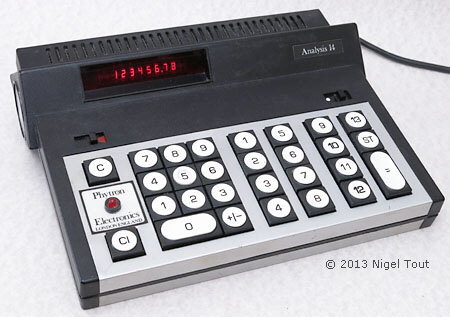
Phytron Analysis 14
Display is 8 digits, red LED.
AC powered.
Size: 255 x 200 x 73 mm (10.0" x 7.9" x 2.9").
The selling price in 1974 was £208[1] [about US$500].
This machine is not a conventional calculator.
It has 13 accumulating memories each with its own key (see photograph above), plus a sub-total (ST) and total register and is designed to be used in
conjunction with a hand-held calculator.
It is primarily aimed at accountancy users, as explained in the extracts below.
In October 1973 the journal "Work Study" reported[2]:
"ANALYSIS MACHINE BOOSTS PRODUCTION
For a cost of £210
an East Midlands engineering company estimates that it has increased production by nearly 15 per cent. and made further savings by obtaining more accurate control of component costs. This was achieved with the aid of Phytron
Electronics Analysis 14 multi-register display analysis and accounting machine. The British-made Analysis 14, which was only introduced to the market in June of this year, incorporates 13 accumulating memories, plus a sub-total and
total register.
The East Midlands company manufactures a range of door and window furniture in both aluminium and zinc base die castings which are afterwards anodised or satin chrome plated respectively. The Analysis 14 was used to examine production schedules, with the time taken for each sequence of operations during manufacture and finishing entered on to individual memories and a total figure obtained automatically. Although there are 29 door and window furniture fittings in the company's range, the Phytron Machine's infinite capacity could cope with them all because it is possible to erase any one of the individual memories - after recording the total - thereby creating additional store capacity.
The company secretary was so impressed with the performance of the Analysis 14 that he is now using it in conjunction with a Phytron battery operated portable calculator, by means of a specially designed base, to give a complete automatic analysis and calculating system, at a total cost of £250. The machine is now capable of all audit and accountancy functions, including calculation of wages, salaries, PAYE and other deductions. The Phytron calculator has the standard four functions of add, subtract, multiply and divide, plus percentage key."
The journal "Accountancy" reported in November 1973[3]:
"One especially interesting bit of news is that a north London
firm of accountants, who specialise in preparing small to medium size companies' accounts, have slashed one-third off the time they spend on clients' wage and salary calculations, by adopting a Phytron Electronics system.
This is the recently introduced Analysis 14 multi-register display accounting and analysis system, which came on to the market only last June.
Its main features are that it has 13 accumulating registers as well as a separate subtotal and total register, and that all its memories are fully independent. Any of them can be individually credited or debited or called on to the eight-digit display, without interfering with the others.
These registers are linked to a Phytron battery-operated portable calculator, which has the four standard functions of add, subtract, multiply and divide, plus a percentage key. The north London firm discovered that because of the 13 memories, they could deal quickly with very complex problems of salaries, wages and PAYE. They found it possible to enter gross wage or salary, previous gross, total gross to date, total gross tax deducted, and less previous deductions, resulting in net tax deductible, and still leave enough memories free for the other miscellaneous deductions such as NHI, graduated pension, trade union contributions, HSA and holiday fund. The entire system cost them £250.
The Phytron system has, of course, much wider uses than these. Functions anticipated by its designers include many audit, cost analysis, stocktaking and sales forecast jobs: the object of the large number of registers was to provide an ample number of columns for detailed analyses of many kinds.
Among the problems it was tried out on in the prototype stage were component cost calculations for engineering projects, and costing and inventory preparation for the stocks of a large timber yard."
The journal Practical Electronics was not very impressed with this machine[4]:
"Multi-memory Machine
On the Advance Electronics stand and in fact using the same case as the Advance calculators was a new accounting aid from Phytron. Called the Analysis 14 this calculator incorporates 13 accumulating
memories each of which can be debited or credited at any time simply by selecting the required store with one of thirteen keys. Only credit and debit (i.e. addition and subtraction) are available, the manufacturers suggesting
that this instrument is to complement, rather than replace, the normal desk calculator which can multiply and divide.
At £210 [GBP, about US$500] this calculator cannot really be termed inexpensive by modern standards and one wonders whether a machine without a print-out is really useful in accounting where mistakes cost money."
Operating the machine
From reading the above extracts which mention that this machine works with a hand-held 4-function calculator we had originally thought that the two were connected electronically, but there is nowhere on
this machine for a cable to be connected.
So we conclude that the numbers must be manually entered into this machine after reading them from the display of the hand-held calculator.
From experimentation the way it might work is as follows:
- The right-hand switch (above the keyboard) sets the decimal point.
Moved to the right, so that it shows the white spot, sets the machine to display a fixed decimal point with two places of decimals (i.e. suitable for currency calculations), as in the photograph above. - Moved to the left, so that the white spot disappears, and the decimal point is totally removed so only whole numbers are displayed.
- Enter a number, and press one of the 13 memory keys to enter the number into that memory.
- Enter a second number and press the same memory key. This will add the second number to the contents already in that memory. To subtract a number press the "+/-" key after entering it.
- Press the "Cl" key to clear the display.
- Press the memory key that we have been using and then press the "=" key and the total in that memory will be displayed and the memory will be cleared back to zero.
However, the memory keys of the actual machine used appear to be all linked together. Pressing any one is equivalent to pressing any other, so there is effectively only one memory. There may be
a problem with this machine, or the operating method has not been deduced correctly.
If you have further information about the operating method of this machine please get in touch.
Grateful thanks are given to Lindon Sear for very generously donating this interesting and unusual machine.
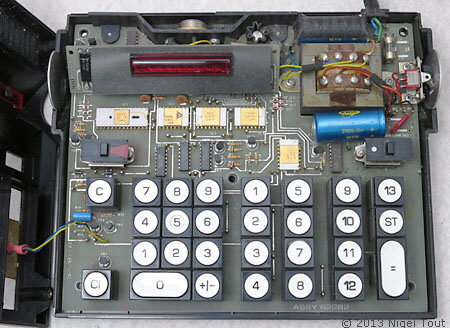
With the casing opened to show the circuit board.
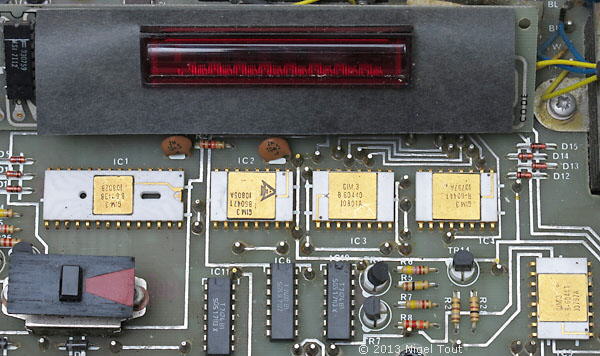
Close up of the integrated circuits - The white ceramic packaged ones are manufactured by General Instruments Microelectronics, while the one that is second from the left also carries the Advance
Electronics 'A' logo.
From left to right they are marked:
|
GIM 3 |
|
B-60438 |
|
10802B |
|
GIM 3 |
|
B-60471 |
|
10805A |
|
GIM 3 |
|
B-60440 |
|
10801A |
|
GIM 3 |
|
B-60441 |
|
10797A |
|
GIM 3 |
|
B-60441 |
|
10797A |
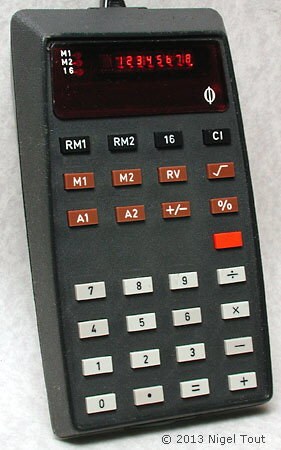
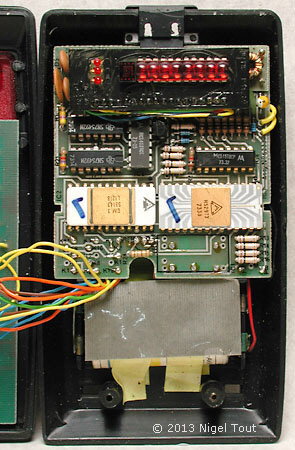
Phytron 32, aka Advance 82R
Display is 8 digits, red LED.
5.5v (5x rechargeable AA batteries).
Four functions, %, 2 memories, square root. Can calculate to 16 digits.
Main integrated circuits: General Instrument Microelectronics GIM3 53143 and one marked H52973 (here date coded to mid-1973). Both have the Advance Electronics "A" logo printed on them, since they are custom designs for Advance manufactured by GIM. This circuit board is similar to that used in the Advance 88 featured on this site.
Size: 87 x 181 x 45 mm (3.4" x 7.1" x 1.75").
The selling price in 1974 was £136[1] [about US$320].
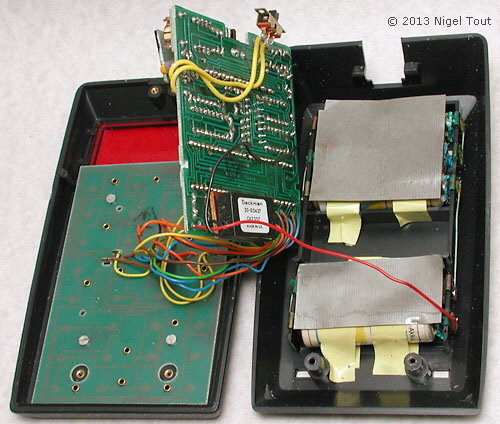
Underneath the circuit board are three more AA rechargeable cells, to give a total of five.
This model was made by Advance Electronics.
The publication "Electronic Calculator Markets and Suppliers", 1974, gives the price at £136 Sterling[1] [about US$320], which is very high, but this example was bought at the Advance Electronics factory shop on 24th October 1975 for £10-80 [about US$25]. The invoice describes it as an Advance 82R.
Graham Lewendon was for a time the only inspector on the hand-held calculator assembly line at the Advance Electronics Bishop's Stortford factory. Graham recalls:
"I clearly remember the introduction
of the Phytron 32 as it used a different keyboard made in house at the Bishop's Stortford factory. Also it was supplied with an internal set of rechargeable batteries, and the game we had getting the first products made to
fit together until we learnt the knack!"
There are more of Graham's recollections on the Advance Electronics page.
This chunky model is unusual for a non-scientific hand-held model of this time in that it calculates to 16-digits, has 2 memories, and requires 2 main integrated circuits. The published price is very high (two ceramic packaged integrated circuits would be expensive) and it may have been sold off cheaply in 1975, by which time the cost of calculators had plummeted.
References:
- Milton, R., Beaumont, A.J. (1974), Electronic Calculator Markets and Suppliers, 2nd. ed., Finresearch Series, London: Ovum, p109.
- "Analysis Machine Boosts Production", Work Study, Vol. 22 Iss. 10, Oct. 1973, p.42.
- "Season of New Computer Ideas", Accountancy, Nov. 1973, p78.
- "Multi-memory Machine", Practical Electronics, August 1973, p690.
Vintage British Calculators
Text & photographs copyright, except where stated otherwise, © Nigel Tout 2000-2025.